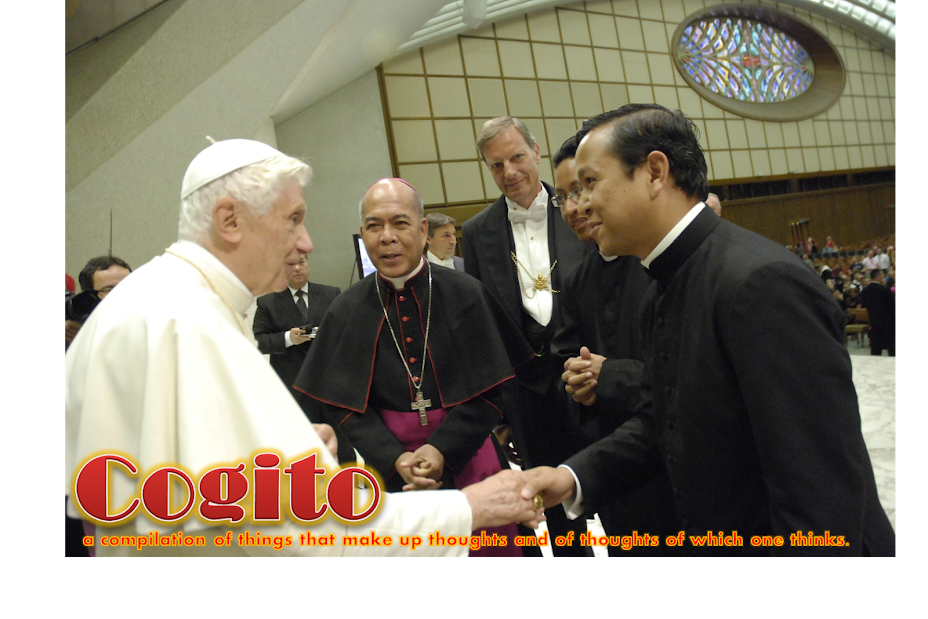Homily
December 17, 2014
Ang Unang Pagbasa kabahin sa gitawag nato nga “Panalangin ni Jacob” (The Blessings of Jacob). Gipatawag ni Jacob ang iyang mga anak ug giingnan: “Pagtigum kamo, ug patalinghugi ninyo, mga anak ni Jacob; Ug magpatalinghug kamo sa inyong amahan nga si Israel” (Gen. 49:2). Atong ma-obserbahan nga ang panalangin nga gihatag ni Jacob sa iyang mga anak, ilabi na kang Judah, nga karon atong nadungog, nagdala usab ug usa ka panagna (prophecy).
Panalangin
nga nahimong panagna, kining tanan hingpit nga natuman diha kang Kristo.
Tulo ka mga panalangin-nga-panagna
(blessing-prophecy) nga natuman diha kang Kristo:
a) “Pagadayegon ka sa imong mga igsoong
lalake: Ang imong kamot anha sa liog sa imong mga kaaway; Ang mga anak sa imong
amahan managyukbo kanimo” (Gen. 49: 8). Natuman kini sa panahon ni
David, kaliwat ni Judah nga maoy naghari sa Israel sulod sa 40 ka tuig.
Gibuntog ni David ang tanang mga kaaway sa Israel ug giyukboan siya sa mga hari
sa yuta sa Canaan. Apan si Hesus ang
kahingpitan sa katumanan niining maong panagna. Gibuntog Niya ang kaaway sa
tanan (the ultimate enemy): ang sala. “At the name of Jesus, every knee shall bend in the heavens and on
earth, and under the earth” (Phil. 2: 10).
b) “Si Juda itoy sa leon… nga nagtikotkot
siya, ug milukso siya ingon sa leon, Ug mao kini ingon sa leon nga baye. Kinsa
ang magapukaw niini?” (Gen. 49: 9). Ang leon mao ang hari sa mga
mabangis nga mga mananap. He is the
terror of the forest when he roars – the Lion King. Kung makatangag siya ug
biktima, walang mangahas mokalaban kaniya. By
this it is foretold that the tribe of Judah should become very formidable, and
should not only obtain great victories but should peaceably enjoy what was got
by those victories. Judah is compared not to a lion rampant, always raging but
to a lion couching, enjoying the satisfaction of his success. Usa ka Leon
nga nagtamasa (enjoying) sa iyang
kadaugan. Kining tanan natuman diha kang Hesus. Sa basahon sa Gipadayag (5:5), si Hesus gitawag nga “Leon sa Banay ni
Judah”.
c) “Ang
cetro sa gahum dili pagakuhaon kang Juda, Hangtud nga moabut si Shilo; Ug maiya
ang pagka-masinulondon sa mga katawhan” (Gen. 49: 10). Tinood man, wala gayod makuha gikan sa
banay ni Judah ang pagkapangulo sa Israel hangtod nga natawo si Hesus, kaliwat
ni David, kaliwat ni Judah.
Sa atong Ebanghelyo, gisubay
ni San Mateo ang kaliwat ni Hesus. Importante kaayo alang sa mga Judio ang
pagsubay sa ilang kagikan. For the Jews, knowing or tracing their genealogies is very important
because these are proofs of their
belongingness to the chosen people of God, Israel. Buot ni Mateo ipakita nga si Hesus mao ang katumanan sa mga blessings-prophecy ni Jacob.
Unsa
man ang mga pagtulun-an nga atong makutlo gikan niining maong kagikan (genealogy)
ni Hesus? Adunay tulo:
1)
God is
faithful to His promise. Ang tawo mamahimo pang dili motuman sa
iyang saad; apan ang Diyos makanunayon. Pipila na ka henerasyon ang milabay,
apan gituman gihapon Niya ang iyang panaad pinaagi kang Jacob. Kita kaha: faithful ba kaha kita sa atong
mga panaad sa Ginoo?
2)
God
can write straight with crooked lines. Most
of the time, we put obstacle to God’s grace with our infidelities and
sinfulness. But God even uses our failures, sins and weaknesses as instruments
to show us His mercy. Nakita nato kini sa family tree ni Kristo. The
Gospel makes no effort to “sanitize” his origins, or the members of his
immediate family. There are FOUR women with defects mentioned: Tamar, Rahab, Ruth, and Bathsheba.
·
The
story of Tamar is a story of incest. Tamar
was the daughter-in-law of Judah with whom she slept because Judah’s sons could
not give her children.
·
Rahab’s
is a story of a prostitute, not even a Jew, who protected the spies
of Israel as they were preparing to demolish her city, Jericho. As a result of
her sacrifice, she and her family were protected.
·
Ruth’s
story is that of fidelity of a woman who did not belong to God’s
people.
·
Bathsheba’s story is that of infidelity.
Despite these defects, God still realizes
His plan. If God accepts all our defects and still continues to do good to us,
to bless us and to do good to others through us, how can we not tolerate the
defects of others and continue to do good despite the fact that we see their
defects?
3)
Jesus
fully entered our human condition, with all its virtues and vices. Si
Hesus tinood nga Diyos ug tinood nga tawo. When
He fully accepted and embraced the human nature, the Son of God really did become
one of us except sin. And, if Jesus was totally
incarnated in the world so that he could communicate the message of God’s
love to the world, then we, too, must be totally incarnated. As St. Josemaria
said: “In order to become more divine,
we have to become more human”. If we think that, in order to be true to
Jesus, we have to separate ourselves from a material and sinful world, we are
not true to our calling. We cannot be
the “salt” of the earth, unless we are fully inserted into it. But we can
do that only when we also fully identify
with the values and concerns of the Kingdom of God. Otherwise we are salt without taste.
Let
us ask the Blessed Virgin Mary to help us remain faithful to God despite our “crooked
lines”. As we venerate the Sacred Humanity of Jesus, may we learn to become
more human, so as to become more divine. Amen.


